The Ultimate Guide to a
Stronger Innovation System
BECAUSE INNOVATION DRIVES GROWTH
BECAUSE INNOVATION DRIVES GROWTH
TABLE OF CONTENTS
Why do we even need an innovation system?
What do we NOT mean by an innovation system?
What are the six dimensions of a strong Innovation Management System?
Glossary of the 6 Innovation System Dimensions
How to measure your innovation system
Leaders need to reflect on the system assessment findings
Compare your innovation system to relevant benchmarks
Leaders must lead the innovation system change
Pay close attention to the employee experience of the system
Drive the goals down to KPIs through all levels of the organization
Ensure leadership upholds the innovation system
Deal swiftly with resistors and blockers
Change happens in small moments that can become legendary
If you hang out in the corporate innovation scene, you will hear the term “innovation management system,” or an “innovation system” for short. But what do people mean by this fancy-sounding term?
Before we define “innovation system,” let’s acknowledge the elephant in the room right upfront: To some of us, the idea of systematizing innovation is an oxymoron. To others, it is common sense to bring some sort of repeatable system to this vast and vital activity on which the future of the organization may depend. At Swarm, we take the middle view that excessive focus on the innovation management system can lead to bureaucratic overload that crushes actual innovation. On the other hand, we believe that innovation does require stewardship in order to avoid lurching from one fashion trend to another. The common sense measure of a good innovation system is that it produces more real innovation than you get without a system.
At the macro level, some countries and world regions have developed their own innovation systems and related standards. These systems define the roles of government, academia and private industry in driving innovation for their constituents. Sometimes these governments favor entities that comply with their systems and standards, awarding contracts or grant money over non-compliant entities. In this article, we are not interested in national or regional innovation systems. Nor will we address standardization for the sake of certifying compliance. We will leave that topic to the International Standards Organization and its members.
On the other end of the spectrum, you will at times hear the terms “innovation management system” and “idea management system” used interchangeably. We view an idea management system as a component of the larger innovation system at a firm level. This article will not address idea management systems. There are many such systems, and analysts such as Forrester and Gartner do a good job of reviewing their features.
An innovation management system is simply a set of practices that are designed to repeatedly produce successful innovation. Numerous studies on innovation management systems across sectors surface the same handful of elements of an effective IM system. One can expand these major elements into greater detail, and cluster the ingredients in a myriad of ways. Beyond the core elements, one can go crazy and add “systems for measuring the system” and all of the ancillary supports one might eventually need, but we leave that to the standards gurus. Our focus here is the innovation practitioner who wants to develop a complete and rigorous — yet not ponderous — innovation management system that actually produces results.
How did we arrive at the core dimensions of an IM system for this article? We relied on three major sources:
Based on our meta research, our ISO experience, and our deep Silicon Valley experience, these are the questions any good IM system must answer:
Beyond these essential six dimensions of IM systems, you can find miscellaneous “bells and whistles,” such as knowledge management, IP management, and the various technologies for managing innovation. However, these six dimensions are the foundation of a strong, yet not burdensome, innovation management system.
You can answer the above questions in many different ways based on your organization’s ambitions and strategies. You can then design your own innovation system that suits your situation.
But if your goal is to become an innovation high-performer, we ought to answer these questions based on what innovation leaders do. Innovation leaders produce innovation with greater success than average. So here are our own definitions of these six dimensions, based on innovation leaders’ best practices:
So with the above glossary, we hope you can sketch out the elements of your innovation system. But designing your innovation system is only the first step. As Peter Drucker, the renowned management consultant, once said, “What you don’t measure, you can’t change.” So we recommend that you take a baseline measure of your innovation system, set some goals for change, and then re-measure the system every 6-12 months. How clear is your system today? How well are you upholding the system to start with?
There are a number of innovation system assessments out there. Some are based on research, others more on observation and opinion. In your search for the right system assessment for your organization, be wary of instruments that mix up innovation culture (which is about supporting desired employee behaviors) and innovation system (which is about resource allocation and decision-making).
In your search for the right system assessment for your organization, be wary of instruments that mix up innovation culture and innovation system.
To drive this point home, let’s talk about some examples we have seen:
This is why Swarm measures the eight dimensions of Innovation Culture, and the six dimensions of Innovation System. While part of the same assessment, each is reported separately to help leaders hone in on the exact dimensions that need work. Read more about Innovation Culture here.
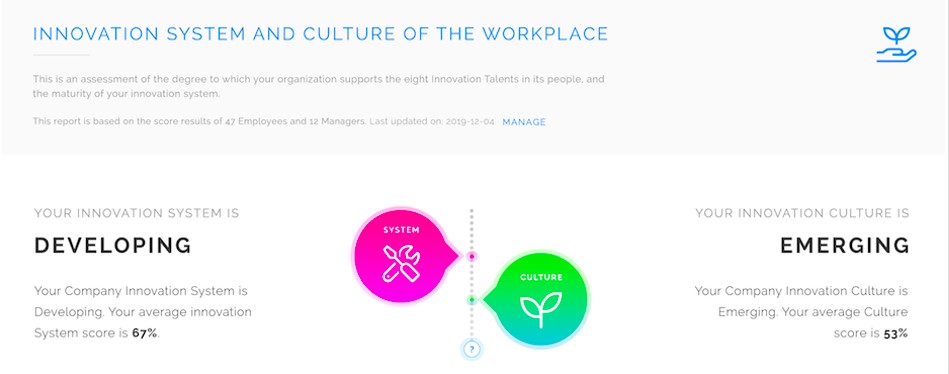
When assessing your innovation system, you need a sufficient sample size so the conclusions are credible. Here are some easy rules of thumb for sample size. For any organizational assessment, you need at least a 95 percent confidence level and no more than a +/- 3 percentage point margin of error for the results to be credible. Here are the minimum sample sizes for different workforce populations:
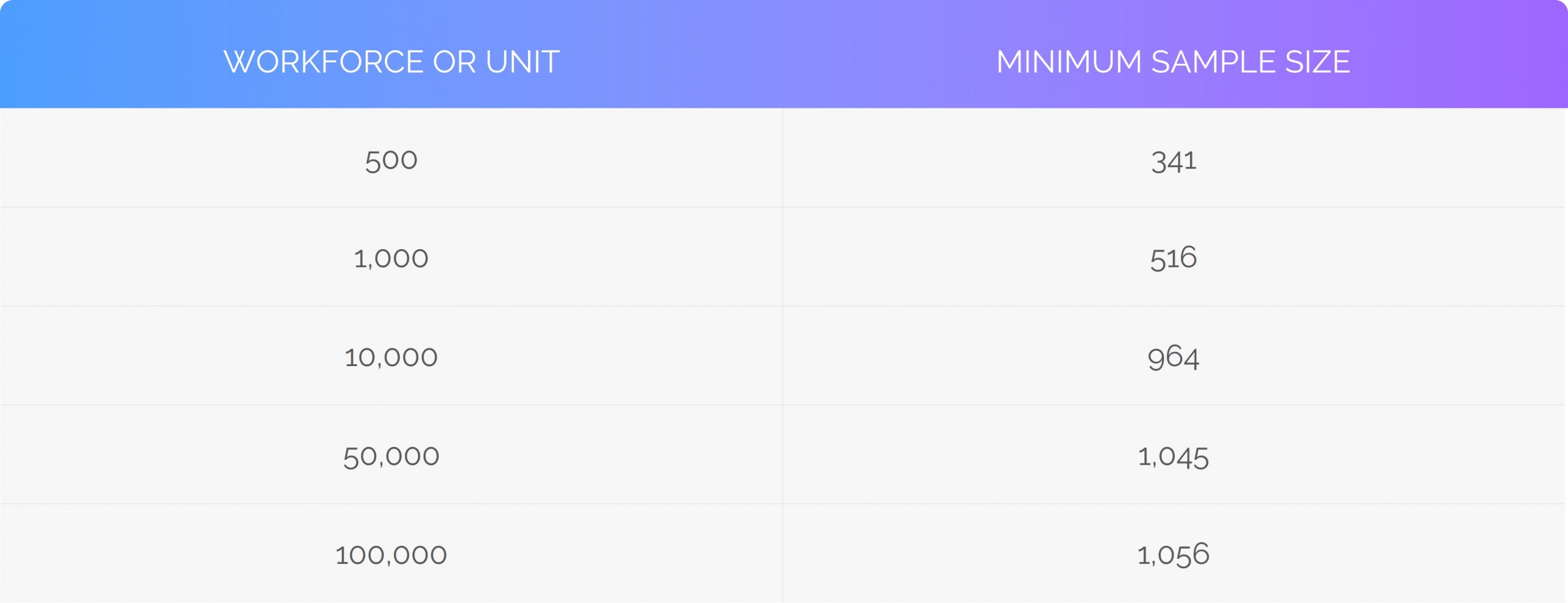
You can calculate the sample size required for different population sizes here.
Keep in mind that for any “unit” you want to compare to another “unit” (say one business unit or location to another) you need to collect a sufficient sample from each unit for the findings to be reliable. So for example, if you want to compare IT in North America with IT in Europe and they each have 500 employees, you need to sample 341 IT employees in each of the two locations.
In the example below, to compare two locations or functions, each needs to have a stable sample size given the total workforce in the unit.

Once you’ve measured the innovation system, the next step is for the leadership team to honestly reflect on the findings.
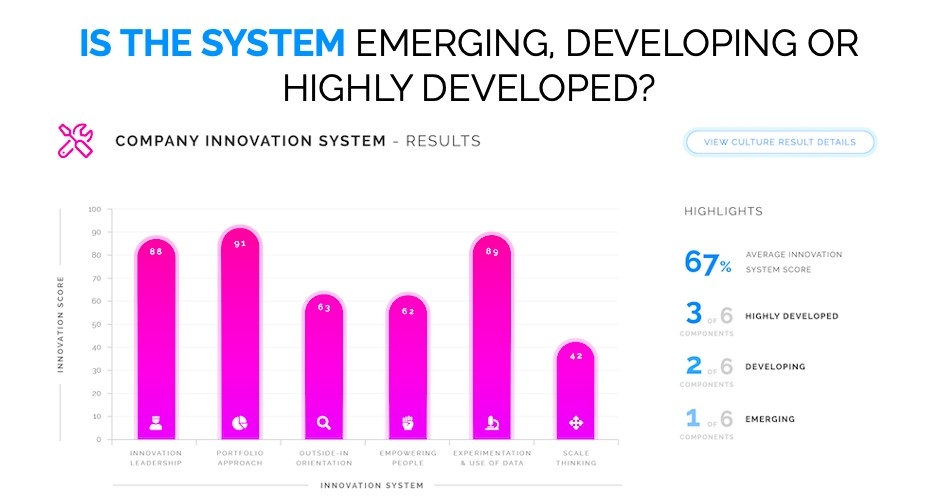
So you assess your innovation system and get some scores. What should you compare your innovation system results to? A good innovation system instrument will provide some sort of rating system based on research. It will allow you to benchmark your organization at least against your sector, and ideally against innovation leaders. But choose your comparisons thoughtfully. If your whole sector is slow to respond to change, what good is it to be 3 percent better than your sector?
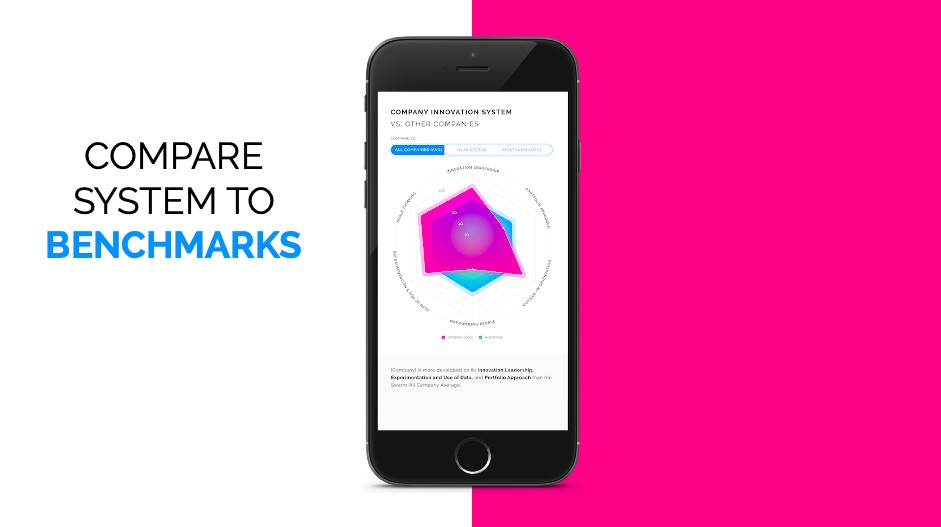
Once leaders have reflected on the system assessment and applied the relevant benchmarks, they must lead the change. Simply put, change at a system level must come from the top. That is because to create or modify an innovation system across the company can involve decisions with major implications. For example, the company’s very structure may hinder its efforts to drive an outside-in orientation. Employees need to be in contact with outside stakeholders, sensing and exploring trends. Changing the company structure from a top-down organization to, say, a “network of networks” is a major undertaking. Yet it is one that may well pay off in greater agility.
Or, say the company has predominantly invested in continuous improvement in the past. In order to prevent being disrupted from the outside, leadership determines they need to shift some resources to Horizons 2 (adjacent) or Horizon 3 (transformational innovation). Top leadership has to make that call. There will be resistance to this change as it entails exploring adjacent or transformational opportunities where the “rules” are unfamiliar. Indeed, Horizon 3 innovation can pose a threat to the current business model and the company’s current “cash cow.” Consider Kodak, which had lots of intellectual property around digital imaging. But Kodak chose not to pursue digital photography because they feared a future without physical film, their cash cow.
It is understood that the C-suite can make multi-million dollar decisions and cut through red tape to get things done. But the rank and file usually has to follow a lot of rules and procedures designed to produce predictable results and avoid risk. Naturally, leadership tends to focus on the innovation system that they experience. Leaders may be exempt from some rules, or know how to work the rules. But the rank and file usually has a very different experience.
So be sure to gather feedback on the innovation system throughout the organization. If the innovation system is working, everyone down to the front desk receptionist should be able to innovate, not just the “powers that be.”
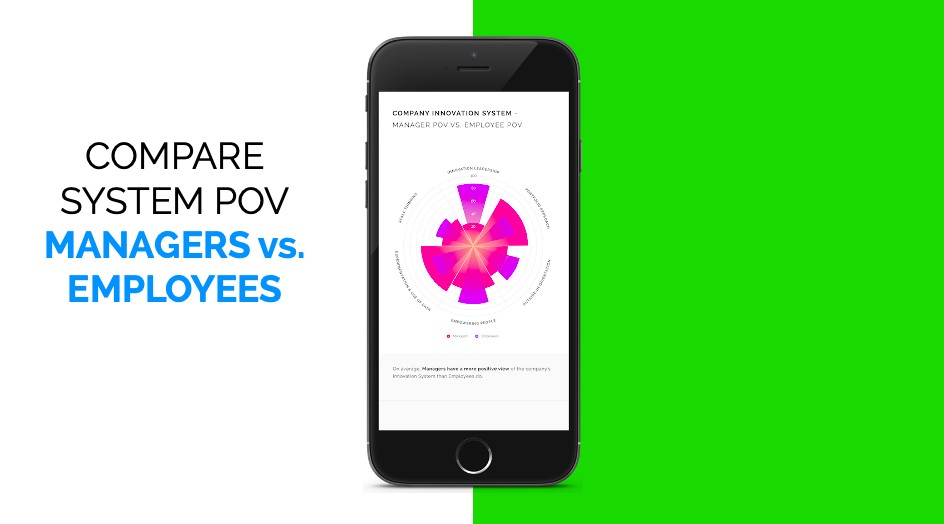
Just because leadership announces a change initiative doesn’t mean the middle will instantly line up. In fact, many middle managers are experts at dodging the “initiative du jour” until it fades away, or a new leader steps in. (See more on blockers and resistors below). Unless a goal is on a manager or employee’s KPIs (or OKRs), don’t expect it to be taken seriously.
In order for change to happen, goals must be tangible and measurable. You must reward leaders, managers and employees alike for meeting the KPIs if you want the behavior change to continue. Carrot and stick can be combined to both encourage the change you want to see and make resistance to change more uncomfortable than the change itself.
Carrot and stick can be combined to both encourage the change you want to see and make resistance to change more uncomfortable than the change itself.
Since the innovation system is driven from the top, leaders must uphold the innovation system in their day-to-day actions. Let’s say leadership has decided to encourage experimentation and data in decision-making around innovation. Then they can’t very well make an opaque decision to randomly kill an innovation that is getting market traction, simply based on a subjective hunch.
Since the innovation system is driven from the top, leaders must uphold the innovation system in their day-to-day actions.
This can be inconvenient but the pay-off in employee trust and system effectiveness is incalculable. Now when you ask an employee to make a recommendation, they will know they must come prepared with data, not hunches.
In any change initiative, you will face resistance. As you launch an innovation initiative, those who repeatedly block, resist or undermine the desired innovation system must be put on notice. You can’t say on the one hand that you want to be an innovation leader while also tolerating these antibodies who actively or passively resist all change. In a study of transformation initiatives across many companies, one of the major errors was not dealing with blockers earlier.
Decisive action (or the failure to take it), says more about how serious you are about the innovation system than 10,000 words. After all, employees watch what we do, not what we say!
As you take the above steps, be sure to celebrate even small successes and progress on the innovation system. Change tends to happen in small moments that can become quite symbolic. You’d be surprised how these stories are passed along among employees and become legendary.
For example, in a recent engagement with the federal government, an employee pursued an innovation on his own by liaising with some other federal agencies. Instead of punishing this action of reaching beyond his responsibilities, his direct boss rewarded the employee’s initiative. Not only did the other agencies support the initiative, but they brought additional resources to bear on it. The initiative advanced, the employee felt supported, and the agency increased its outside-in orientation.
Celebrate even small successes and progress on the innovation system. Change tends to happen in small moments that can become quite legendary.
Famously, Drucker said “What you don’t measure you can’t improve,” spawning the data-fication of everything. It follows that you need to monitor the innovation system regularly. At minimum, you should measure the innovation system annually. How well is the system being upheld, and how well is it producing the kind of innovation you want? Once you have your baseline data, you can assess the organization on a rolling basis to avoid survey burnout.
To summarize the fifteen key points in this article:
In conclusion, the payoff for a strong innovation system is a stream of high-value innovations reaching the market swiftly, and achieving impact – whether that is financial or societal. Not only will such innovations drive a wedge between you and your competitors in the market, but innovative companies also attract higher quality talent. And last but not least, for every dollar of revenue a company earns, the market valuation for innovative companies is significantly higher – which is why investment in a strong innovation system should be every leader’s priority.